RARE Antique Art Glass End-Of-Day Miniature Oil Lamp with applied feet, S1-549
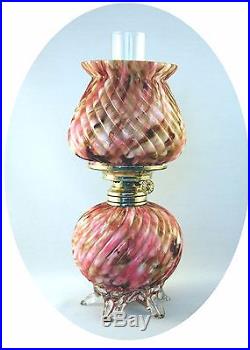
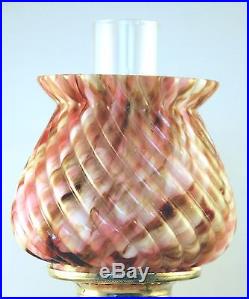

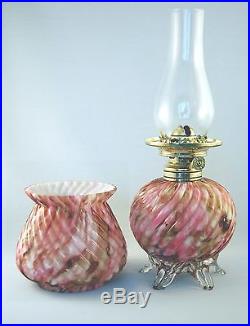
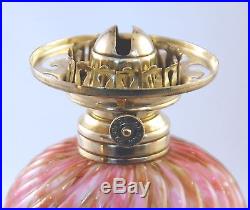
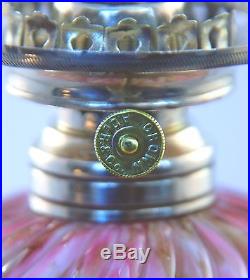
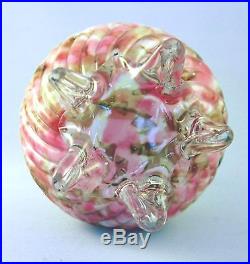

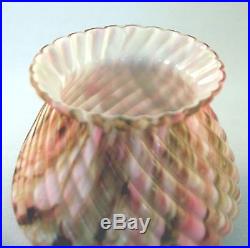


RARE End-of-Day Art Glass Miniature Oil Lamp, S1-549. Cased End-of-Day Art Glass Miniature Oil Lamp, S1-549. About 8 1/2 tall to top of shade.
About 3 1/2 in width from foot tip to foot tip. Cased End-of-Day Art Glass Night Lamp. Size 0 Hornet burner marked CROWN A. Minor polishing, as made, to tips of applied feet.
From the Marjorie Hulsebus collection. Background & History : A lamp like this, although in different colors of glass, is shown in Figure 549 of Frank & Ruth Smith's book "Miniature Lamps". While the lamp in the book is made of pink, green, brown and white glass, this lamp is made of dark pink, light pink, gray, amethyst, brown and white glass.
While end-of-day glass may have originated this way, it seems obvious that at least some glass making houses intentionally made production items out of randomly mixed colors of glass. As we understand it, the process involved first making a simple shape of a single colored glass (in this case a white glass), then rolling that piece of glass over mixed bits (somewhat like a very coarse powder) of colored glass on a steel table (called a "marver"). Once coated with the colored glass, the item was reheated and either blown or molded into its desired final shape.When made this way, the finished item is said to be "cased"; that is there is an inner solid color of glass encased in the multi-colored glass. With this lamp, after the font was made, a skilled glassmaker added the crystal clear applied feet. Generally speaking, art glass lamps like this one were not made in large quantities most likely because the process of making them was time consuming and required the skills of a master glass maker. That is one reason why many of these fine art glass lamps are so hard to find today; there just weren't very many of them made. And, in fact, over the past 13 1/2 years, we've only ever seen three examples of this lamp offered for sale and two of those (including this one) were offered at specialized miniature lamp live auctions.
Again, probably because these lamps were made in small quantities usually by, we think, smaller companies specializing in art glass (or small divisions of larger companies) they were not advertised, or at least not widely advertised in the glass trade press. Thus there is no documented evidence of what company made this lamp or when it was made. But we can tell that it is at least 100 years old. We know that from the fact that the clear glass feet glow (see the last photo) or fluoresce, when viewed under "black" light.
(This phenomenon and how it can be used to ascertain that a lamp was made sometime before World War I is explained in a note below). But when we viewed this lamp under black light, we noticed that in addition to the clear glass feet fluorescing, some of the colored glass on the font and shade also glowed; instead, however, of glowing a yellowish green like the feet, these spots fluoresced with a bright orange color.We can't tell exactly which of the many colors on this lamp glowed orange, but we do know that manganese (either a different oxide than used as a clarifying agent, or simply more manganese dioxide) when used as a coloring agent will result in this orange glow. This lamp is in excellent condition with no discernible signs of damage or defect. Upon close inspection it appears that each of the five applied feet has been slightly polished, or ground down on the bottom.
We suspect that this was done when the lamp was made to ensure that it stood level on a table or other surface. The brass hardware (consisting of a plain double ring collar, a size 0 Hornet style burner and a shade ring) has been polished and is also in fine condition with no defects or damage. The burner thumb wheel is marked CROWN A. " We have been unable to locate any further information about the "A. The thumb wheel turns freely; there is no wick in this lamp. A clear glass chimney with fire polished edges, also in fine condition, completes this lamp. This chimney also fluoresces under black light, so, it too was made sometime before World War I. Measurements of the lamp are to the left underneath the first photo. The combination of multiple complementary colors is quite unusual and along with the lovely swirled rib design of both the font and the shade and the clear glass applied feet, make this an extremely attractive and elegant night lamp. About the Use of Words Like "Scarce" and "Rare".We realize that some eBayers, not having or knowing of a better way of assessing an item's scarcity, use these terms quite subjectively and frequently based on their own personal experience. They simply don't know whether an item is common, scarce or rare. We take two steps to describe the scarcity of a lamp. First, we only use the words "Scarce", "Rare", "Very Rare", "Very Very Rare" and "Extremely Rare" if the item in question is judged to be so by an acknowledged outside and independent source. For miniature lamps, we use the ratings in Marjorie Hulsebus 2006 edition of the "Price Guide for Miniature Lamps".
Marjorie's ratings are also somewhat subjective (they are based on the collective view of a panel of 12 experienced miniature lamps collectors--we were members of that panel), but were at least arrived at independently of the sale or offering of any particular lamp. We keep all of this data in an online database and make the database available free of charge to members of the Night Light Club and to others who have requested access. Fluorescence in Old Clear Glass.
, found naturally as the mineral Pyrolusite, was used by by glass makers, as far back as ancient Egyptian and Roman times and up until about 1915, as a decolorizing agent in order to make clear, colorless glass. The natural material used to make glass contains iron impurities.These impurities impart a coke-bottle green (and sometimes brown) color to the glass. Manganese dioxide, added to the molten glass mixture, neutralizes the coloring effects of the iron impurities. Adding manganese to glass has a side-effect of which we doubt old glass makers were aware. While not itself fluorescent, manganese activates fluorescence in other elements or compounds.
Clear glass which has had manganese dioxide added to it will glow with a green or yellow-green color when viewed under long wave ultra-violet ("black") light. This fluorescence turns out to be a useful test of the age of clear glass. The United States does not have large amounts of naturally occurring Pyrolusite; the mineral has to be imported from places like the Ukraine, South Africa, Brazil, Australia and China. After the outbreak of World War I in Europe, manganese became increasingly hard to get; first, it was considered a strategic war material (it is essential to iron and steel production) and, second, the normal supplies lines were disrupted by the war.
And, so, after about 1915, U. Glass makers switched to other decolorizing agents e. Thus, clear glass which fluoresces (glows) under long wave ultra-violet (UVA or "black") light can be presumed to have been made before 1915. Incidentally, manganese dioxide is also the compound responsible for the "sun-purpling" of old clear glass; when exposed to short-wave ultra-violet light (UVC) (present in sun-light, or in germicidal lamps) over an extended period of time, the manganese dioxide will impart a purplish color to the glass. It has been reported that unscrupulous antique dealers especially in the Southwestern U. Would intentionally expose old glass to the intense desert sun (or to ultra-violet germicidal lamps) to create this purple color. Purists among glass collectors consider this to be a travesty and believe that intentional or artificial sun-purpling decreases, rather than enhances, the value of old glass items. Note that is can be quite challenging to get an accurate i. That looks the same as what one sees with their eyes photograph of the fluorescence in the glass. We work hard to get a photograph that looks like what we see, but there is usually some minor discrepancy either in the exact color or amount of the fluorescence.Should you examine a fluorescent lamp under black light, in a darkened environment, it will glow, but may not look exactly like the photograph we provided. The contents of this listing are protected by U. The use of substantial portions of this listing verbatim or with only inconsequential changes without the express written consent of the authors is prohibited.
Our objective is to have happy, satisfied customers. We will work with you to satisfactorily resolve any problems.We try to answer all questions promptly. We do our best to describe all items accurately. However, mistakes and oversights can occur. Please also note that the receiving country's Custom Service may cause delays in item's arrival. Interested in learning more about miniature lamps?
Want to meet other miniature lamp collectors? PLEASE CHECK OUT OUR OTHER AUCTIONS.
The item "RARE Antique Art Glass End-Of-Day Miniature Oil Lamp with applied feet, S1-549" is in sale since Tuesday, February 02, 2016. This item is in the category "Collectibles\Lamps, Lighting\Lamps\ Non-Electric\Miniature". The seller is "kayschwartz" and is located in Stockton, New Jersey. This item can be shipped worldwide.